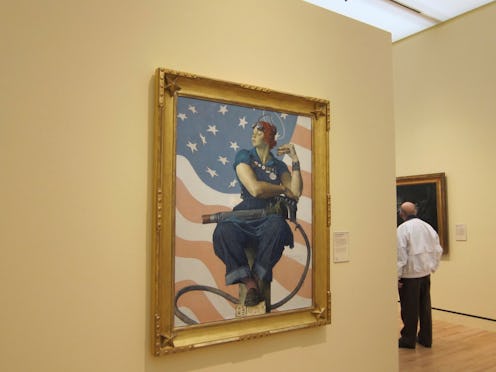News
Rosie The Riveter Model Passes Away

The woman who modeled for Norman Rockwell's iconic Rosie the Riveter painting, Mary Doyle Keefe, has died in Simsbury, Connecticut. Keefe says she was just 18 years old when she agreed to pose for Rockwell's photographer, Gene Pelham. Those shots would be used as the basis of Rosie the Riveter, a painting that was featured on the cover of the May 29, 1943, edition of the Saturday Evening Post, and would help define an entire era of working women.
Keefe was a guest on The Tonight Show with Jay Leno in 1994 during a special show honoring the 50th anniversary of D-Day. She described the poster's importance in both pushing war bonds, a pivotal way in which civilians were able to fund the war by essentially buying government debt, and inspiring women to enter the workforce as a particular point of pride. Keefe told the talk show:
I was very pleased that they could make all this money for the war. I am proud of this painting. It’s a symbol of what the women did for the war, to do their part, and to give up their nail polish.
The term Rosie the Riveter can be traced back to an article about Rosalind P. Walter, an aircraft factory worker who inspired a 1942 big band song of the same name penned by songwriters Redd Evans and John Jacob Loeb and played in regular rotation by the Four Vagabonds. Millions of women took to industrial jobs including in aviation and munitions facilities to help with war efforts during WWII.
Jobs that were previously unavailable to women suddenly became not only viable but a necessary way to serve the country. In the span of five years between 1940 and 1945, the number of women in the workforce jumped from 27 percent to 37 percent. Around that time, the Women’s Army Corps was established as well as the Navy's Women Accepted for Volunteer Emergency Service. As many as 350,000 women served in military positions. Their efforts have been immortalized thanks to the famous J. Howard Miller "We Can Do It" poster as well as Rockwell's Rosie the Riveter painting.
Keefe was never a riveter and was actually a relatively petite woman, so when the time came for Rockwell to paint from her photo study, he chose to depict her as a much more muscular woman. Keefe was paid a total of $10 for her efforts as a model. The first shoot didn't quite work because her attire didn't fit the denim work outfit Rockwell had in mind. For the second shoot, she positioned a fake rivet gun across her lap and indeed held up a real ham sandwich, just as in the painting. An American flag backdrop and Rosie resting her feet on a copy of Mein Kampf were added into the painting, as an explicit show of patriotism and as a kiss off to Hitler.
Some years later, Rockwell actually wrote to Keefe and apologized for bulking her up in his painting, calling her the most beautiful woman that he had ever seen. In a profile of Keefe on her 85th birthday, she recalled the 1967 letter that Rockwell sent. According to Keefe, Rockwell said:
The kidding you took was all my fault, because I really thought you were the most beautiful woman I had ever seen.
When her son Bill was interviewed on her 85th birthday, he described the poster as incredibly important to the family and something he had been aware and proud of since his youth, saying that "it was always a topic of conversation. It's part of the Keefe family legacy. We never had a problem coming up with a unique school project or something for show and tell."
Following the painting's success, Keefe carried on a relatively normal life, serving as a dental hygienist in Bennington, Vermont, after graduating from Temple University in Philadelphia. Keefe and her husband, Robert, were married for over half a century before his death in 2003 and raised their four children in Whitman, Massachusetts, then Nashua, New Hampshire, according to CBS Connecticut.
At the time of her death, Keefe had lived in the McLean retirement home in Simsbury for almost a decade, and during that time continued to autograph Rosie the Riveter posters. She was on hand at Sotheby's when the original painting was auctioned off in 2002 for $4.9 million to the Elliott Yeary Gallery in Aspen, Colorado. It now resides at the Crystal Bridges Museum of American Art in Bentonville, Arkansas.
The symbol of Rosie the Riveter continues to inspire millions of women in a far more contemporary sense, as Rosie has become a symbol of equal pay and bridging the gender pay gap. In the decades since Rosie the Riveter was painted, women have gone from being a minority of the workforce to making up nearly half of all workers in the United States, according to CareerBuilder. Keefe was a trailblazer whose legacy will resonate for decades to come.
Image: MyEyeSees/Flickr